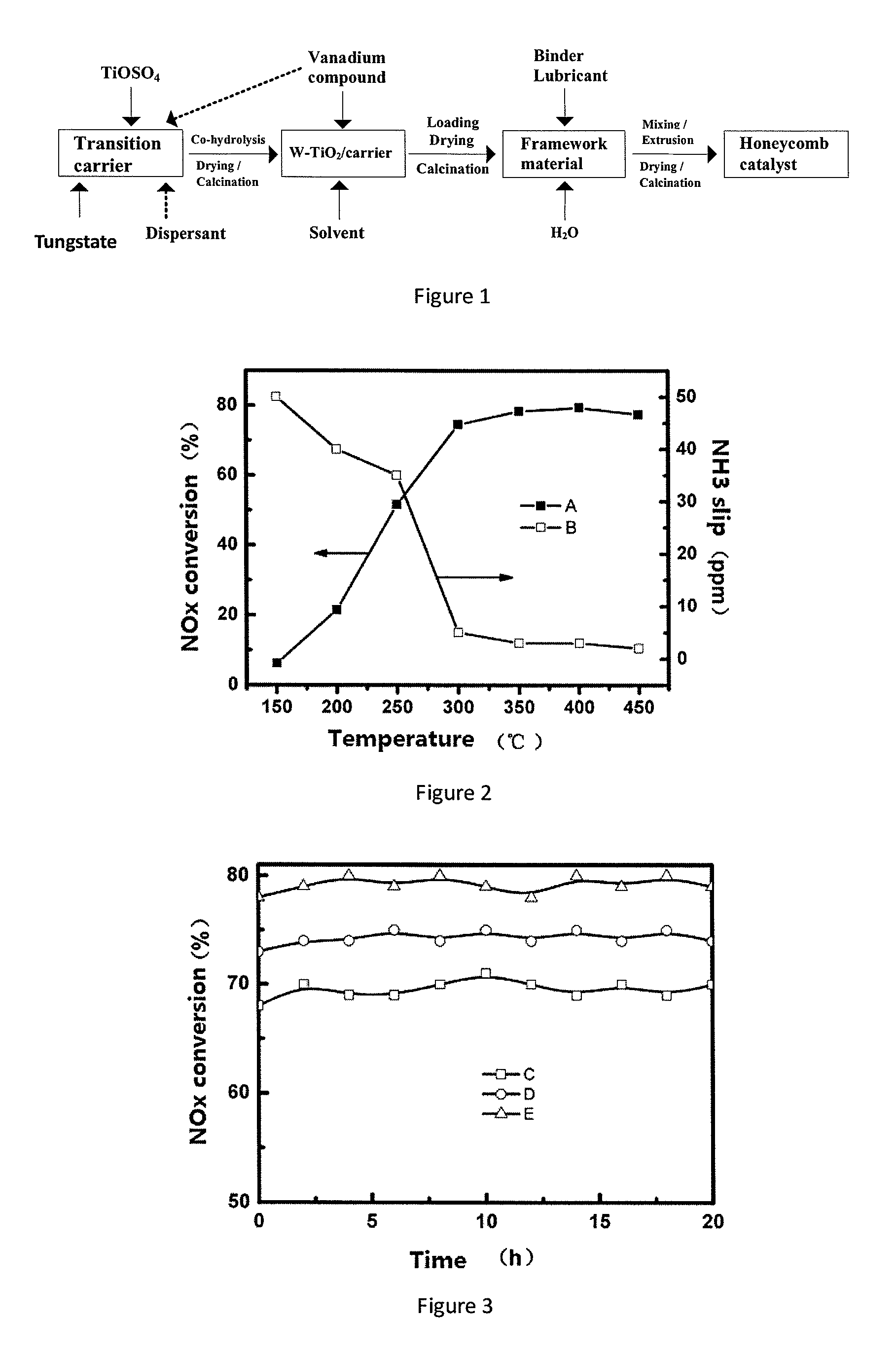Surface deposition-type honeycomb catalyst for flue gas denitrification and preparation method thereof
a technology of denitrification and surface deposition, which is applied in the direction of physical/chemical process catalysts, metal/metal-oxide/metal-hydroxide catalysts, and separation processes, etc. it can solve the problems of destroying the ecosystem of earth, nox emission control becomes a key and difficult problem, and control measures for nox emissions such as nox from power plants and industrial boilers are not mature enough. , to achieve the effect of greatly reducing the cost of the presen
- Summary
- Abstract
- Description
- Claims
- Application Information
AI Technical Summary
Benefits of technology
Problems solved by technology
Method used
Image
Examples
embodiment 1
[0054
[0055]1. Preparation of Composite Carrier
[0056]100 g TiOSO4 was dissolved into 150 mL water, and the mass concentration of TiOSO4 in the resulting solution was about 4.1 mol / L. Then, 5 g Tween-20 was added into the solution, and the mass concentration of Tween-20 in the resulting solution was about 2 wt. %. After the addition of 25 g urea and 50 g active carbon (BET area: 450 m2 / g; particle size: 50-100 μm), the resulting mixture was stirred at 50° C. for 2 h, during which one-step nucleation of meta-titanic acid occurred in the pores and surfaces of active carbon particles, and the mass ratio of the formed TiO2 and carrier was 1:1. The suspension was stirred at 90° C. for 1 h, during which 7.5 g of ammonium meta-tungsten was added dropwise. The suspension was filtered and the filter cake was washed to the neutral pH. The filter cake was dried at 100° C. for 8 h, then the temperature of the filter cake was increased to 500° C. with a rate of 5° C. / min. The filter cake was heate...
embodiment 2
[0061
[0062]1. Preparation of Composite Carrier
[0063]16 g TiOSO4 was dissolved into 1000 mL water, and the mass concentration of TiOSO4 in the resulting solution is about 0.1 mol / L, and 10 g PEG 2000 was added into the solution and its concentration was about 1 wt. %. After addition of 50 g urea, the suspension was stirred at 50° C. until the solid was dissolved, then 80 g carbon black (BET area: 200 m2 / g; particle size: 2 μm) was added to the solution, and the suspension was reacted for 1 h, during which one-step nucleation of meta-titanic acid occurred in the surface of black carbon particles, and the mass ratio of the formed TiO2 and carrier was 1:1. The reaction mixture was stirred at 150° C. for 10 h, during which 1.5 g sodium tungstate was added dropwise. The suspension was treated as in the Embodiment 1. Characterization of the composite carrier with XRD showed that the composite carrier possessed typical anatase of TiO2, and the composite carrier showed strong diffraction pea...
embodiment 3
[0068
[0069]1. Preparation of Composite Carrier
[0070]800 g TiOSO4 was dissolved in 1000 mL water, and the molar concentration of TiOSO4 in the resulting solution was about 5 mol / L. Then 100 g Span-80 was added into the liquid, and the mass concentration of Span-80 in the resulting solution was about 5 wt. %. Then 50 g urea, 50 g ammonium tungstate and 7.2 g vanadyl sulfate were added and the mixture was stirred until a solution was. formed. 100 g polystyrene microballoon (BET area: 200 m2 / g; particle size: 2 μm) was added into the liquid subsequently, and the mixture was stirred for 10 h at 150° C. After the reaction is finished, the suspension was treated as in the step described in the Embodiment 1. The loading amount of V2O5 is 1 wt. % with respect to the mass of TiO2 and the loading amount of WO3 is 10 wt. % with respect to the mass of TiO2. XRD Characterization showed that the composite carrier possessed typically anatase of TiO2, and the composite carrier showed strong diffract...
PUM
| Property | Measurement | Unit |
|---|---|---|
| particle sizes | aaaaa | aaaaa |
| temperature | aaaaa | aaaaa |
| particle size | aaaaa | aaaaa |
Abstract
Description
Claims
Application Information
 Login to View More
Login to View More - R&D
- Intellectual Property
- Life Sciences
- Materials
- Tech Scout
- Unparalleled Data Quality
- Higher Quality Content
- 60% Fewer Hallucinations
Browse by: Latest US Patents, China's latest patents, Technical Efficacy Thesaurus, Application Domain, Technology Topic, Popular Technical Reports.
© 2025 PatSnap. All rights reserved.Legal|Privacy policy|Modern Slavery Act Transparency Statement|Sitemap|About US| Contact US: help@patsnap.com


